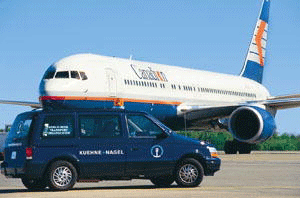High-Tech Looks To Supply Chain
Partners
Timed to coincide with the
ongoing resurgence in this vibrant industry sector a major conference
was held in San Francisco titled “Hi-Tech & Electronics Logistics
Conference."
The Eyefortransport gathering featured a
lot of new players and “futurists” willing to take on more
risk.
 “Now
is the perfect time to invest in research and development,” proclaimed
Kevin Wrenn, senior vice president for operations and quality, Fujitsu. “Now
is the perfect time to invest in research and development,” proclaimed
Kevin Wrenn, senior vice president for operations and quality, Fujitsu.
“As we continue to save money by synchronizing
our global supply chain, we can afford to do more in the way of innovation
and design.”
Indeed, it is Wrenn’s contention that
the reason FedEx and the U.S.Department of Homeland Security rely on Fujitsu
for “mission critical” projects is due to its physical product
flow.
“This one factor forged a whole new
business model for us,” he said.
“Transport is a profit driver with
bottom-line results.”
Supply chain innovation is also a key competitive
differentiator, said Wrenn, noting that R&D ensures that “quality”
becomes part of a business culture, rather than just a temporary adjustment.
“With a single hub of information
linking carriers with their collaborators, a company can squeeze out significant
profit and reduce waste,” he said.
“But only if you pick the right partners
to begin with.”
Knowing when to discontinue part of your
product line is just as important, however.
“Your first loss should be your smallest
loss,” he said.
“By learning which pieces in your
product line are likely to become obsolete, you can develop ways of anticipating
recurrences.
“And with a good distribution system
in place, you should be able to turn on a dime.”
For Fujitsu, “demand planning”
has replaced “forecasting” as an operational strategy. Wrenn
explained that this involves working closely with its freight forwarders
and Customs brokers at several key U.S. air cargo load centers.
“We have identified the greatest domestic
customer sectors, and how we can reach those densified areas through nearby
cargo hubs,” he said.
“So we partner with intermediaries
at LAX, for example, or JFK, or in Dallas, Denver, and Atlanta.”
Fujitsu is the world’s third-largest
IT service provider, with over half of its customers comprising the Fortune
Global 500.
It’s also one of the world’s
top five supply chains for the distribution of servers and PCs.
“Phased implementation is critical
with products that have a legacy problem,” he allowed.” “That’s
why we concentrate on our core competency, and let the specialists deal
with transport.”
Rosalie Cmetak, senior product strategy
manager for Oracle Transportation Management, concurred.
“Whether you are a high-tech organization
servicing your customers directly or a LSP (logistics service provider)
managing transportation and logistics for them, logistics accountability
and visibility are the forefront of your responsibilities,” she
intoned.
With much fanfare last year, Oracle completed
the acquisition of Global Logistics Technologies, Inc. (“G-Log”).
According to Cmelak, Oracle customers in
all industries are being provided with integrated transport solutions
across global supply chains.
“Everyone is facing increasing pressure
to get products to marketfaster,” she said, “and to keep inventory
levels low.
“This takes visibility that only specialists
can provide.”
“Logistics, for most major manufacturers,
has moved from the basement to the Boardroom over the past decade.”
 John
Lebowitz, senior high-tech vice president for Kuehne + Nagel agreed that
data integration and synchronization “is absolutely necessary”
for a leaner supply chain. John
Lebowitz, senior high-tech vice president for Kuehne + Nagel agreed that
data integration and synchronization “is absolutely necessary”
for a leaner supply chain.
“Transportation represents at least
five percent of sales for most of our clients,” he said.
“As a transport manager, you can be
a superstar if you shave off just a few points.”
To do this, he insisted, they must establish
a “single source of truth,” that serves as a common data model.
“This will enable you to manage goods
in a consistent framework within a changing and dynamic network,”
he said.
To Vanita Wells, director of customer operations
at OQO, reliability in a transport partner is a “must.”
“We have very limited ‘people’
resources,’” she said, “so we have to outsource a lot
of transport functions.
“This means building a solid partnership
between our manufacturing and spare parts, service, supply chain and operations
management teams.”
OQO, a world leader in pocketable devices
and miniaturization, is a new company funded primarily by venture capital.
According to Wells, their supply chain philosophy
is “to own the recipe and outsource the sous chef.
“There’s a delicate balance
that has to be struck if you are separating manufacturing and spare parts
operations,” she said.
“On one hand you risk sacrificing
valuable synergies between these two functions.
“On the other hand, a cross-organizational
supply chain can satisfy customer needs in a multi-tiered manner.”
And as far as tiers go, Wells is bullish
on going with the first all the way.
“Who wants to do business with a second-
or third-tier player anyway?” she asks.
“Only the best 3Pls and 4Pls can properly
address velocity, flexibility and transparency in the product pipeline.”
Patrick Burnson
|



